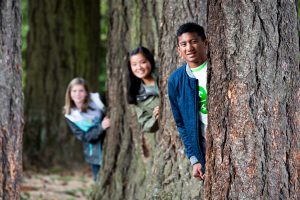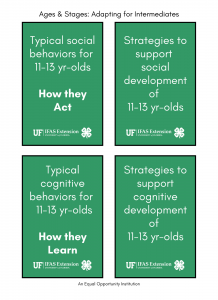 In a recent study, one of the top things 4-H volunteers are looking for are ideas for adapting activities to different age groups (Kent, 2022). Florida 4-H offers experiences for four different age groups: Cloverbuds (ages 5-7), Juniors (ages 8-10), Intermediates (ages 11-13) and Seniors (ages 14-18). One of the great things about 4-H is that the whole family can participate! This also means that 4-H volunteers often find themselves working with a variety of age groups. That might seem a little overwhelming, but this post series gives practical tips and strategies to make it less daunting. This week’s post is focused on adapting activities for intermediate-age 4-H members. In case you missed it, check out the previous couple of weeks posts to learn about cloverbuds and juniors.
In a recent study, one of the top things 4-H volunteers are looking for are ideas for adapting activities to different age groups (Kent, 2022). Florida 4-H offers experiences for four different age groups: Cloverbuds (ages 5-7), Juniors (ages 8-10), Intermediates (ages 11-13) and Seniors (ages 14-18). One of the great things about 4-H is that the whole family can participate! This also means that 4-H volunteers often find themselves working with a variety of age groups. That might seem a little overwhelming, but this post series gives practical tips and strategies to make it less daunting. This week’s post is focused on adapting activities for intermediate-age 4-H members. In case you missed it, check out the previous couple of weeks posts to learn about cloverbuds and juniors.
What are “Ages & Stages” and Why Does it Matter?
“Ages & stages” is a phrase commonly used in youth development that refers to the physical, social, emotional, and cognitive development of a young person. These categories of development are based on the work of researchers such as Piaget and Erickson. Understanding these categories help 4-H volunteers and professionals provide opportunities for youth to thrive through social and emotional learning and are a key part of the 4-H Thrive Model (Arnold & Gagnon, 2020). There are several benefits of selecting (or adapting) age-appropriate activities for youth:
- First, it makes learning fun! Fun is important; boring is bad.
- Youth are more engaged. When activities are not too challenging or too easy, they are in what’s called the “zone of proximal development,” or ZPD (Vygotsky, 1978). This is key to help learners master new skills. ZPD refers to skills or knowledge that are too difficult for a youth to master on their own, but possible to master with guidance from a more knowledgeable person- like their 4-H volunteer!
- Youth can build on past learning experiences and create future opportunities to grow.
- When learning is fun and youth are engaged, youth stay involved in 4-H!
How to Use “Ages & Stages” to help Intermediates Thrive
Social Development of 11-13 year-olds (how they act)
Youth who are 11-13 years old are undergoing several physical changes associated with puberty. Along with the physical changes, youth this age often struggle with personal identity. During this time, adolescents either establish their own sense of self or become confused with who they are and what they want to do in life. Helping youth discover their sparks- their own passions and interests- can help them form their self-identity.
| Typical social behaviors for 11-13-year olds include: | Strategies for supporting social development of 11-13-year olds: |
|
|
Cognitive Development of 11-13-year olds (how they think)
Youth who are 11-13 years old can think logically and apply abstract reasoning. They can also manipulate mental representations. This is a great age to introduce youth to more complex ideas- particularly related to social and scientific issues that may impact their community. One way for youth in this age group to learn is through service-learning. Where they identify a problem in their neighborhood, school, or community, brainstorm solutions, select one, and implement and evaluate it.
| Typical learning behaviors for 11-13-year olds include: | Strategies for Supporting Cognitive Development of 11-13-year olds: |
|
|
 Ages & Stages Application Examples
Ages & Stages Application Examples
Throughout this series, we have been using examples from each of the three pillar programs in 4-H: Citizenship & Leadership, Science, and Healthy Living. These examples are meant to help parents and volunteers see how an activity can be adapted for each of the different age groups. For examples for other age groups, check out our previous post about Cloverbuds and our post about working with Juniors.
- Citizenship & Leadership: For citizenship & leadership, we have been using the example of a 4-H club business meeting. Eleven to 13-year-olds are going to be more interested in learning about leadership roles. Once they have some experience leading meetings at the club level, encourage them to get involved in the county and/or district leadership 4-H council. At this age, they can easily understand the proper order of a business meeting and how to make a motion. Encourage them to model this behavior to younger youth in the club. They may also be interested in leading a committee. Encourage them to be involved in planning club celebrations, fundraisers, and especially service projects.
- Science: For science, we have been using the 4-H entomology project as an example. Entomology is the study of insects. Eleven to 13-year-olds can catch, identify, and pin insects to create an insect collection. This collection could be exhibited at their county or regional fair, and can also be used as part of the 4-H Insectathon contest. Youth this age would enjoy competing in a state event like this!
- Healthy Living: For Healthy Living, we have been using the 4-H personal wellness project as an example. This project area helps youth learn about nutrition, physical fitness, and mental health. For intermediates, ask them to identify a problem at their school or community that has to do with personal wellness. Have them brainstorm solutions, select one, and plan a service project to address the need. After they implement the project, celebrate their accomplishments and help them evaluate and reflect upon their success.
Using the “Ages & Stages” approach with youth reinforces the Essential Elements of 4-H: Belonging, Mastery, Independence, and Generosity. This is also key to helping youth thrive. However, each individual youth grows at their own pace and might not completely meet the general tendencies listed above. As volunteers and 4-H professionals, it is important to observe youth and meet them where they are physically sociality, and intellectually. Adapting activities on the fly gets easier with practice- download this set of flashcards for a quick reference guide You can print them, cut them out, and punch them to fit on a lanyard as a handy teaching aid. Your local 4-H agent is always available to help and provide additional resources if you have questions.
References:
Arnold, M. E. & Gagnon, R. J. (2020). Positive youth development theory in practice: An update on the 4-H Thriving Model. Journal of Youth Development, 15(6), 1-23.
Erikson, E. H. (1963). Childhood and Society (2nd Ed.). New York: Norton.
Kent, H.C. (2022). Informal learning to support volunteer performance. [Unpublished doctoral dissertation]. Florida State University.
Lee, F. and Go, C. (2002). Developmental stages. UC ANR 4-H Youth Development Program.
Piaget, J. (1971). The theory of stages in cognitive development. In D. R. Green, M. P. Ford, & G. B. Flamer, Measurement and Piaget. McGraw-Hill.
Pleskac, S. (2000). Educational design and delivery: Use of age-appropriate activities. VRKC fact sheet.
Vygotsky, L. S. (1978). Mind in society: The development of higher psychological processes. Cambridge, MA: Harvard University Press.
- Meet our Summer Intern- Andy Franklin! - June 13, 2025
- Blue Ribbon Baked Goods - September 23, 2024
- Blue Ribbon Photos and Posters - September 21, 2024
